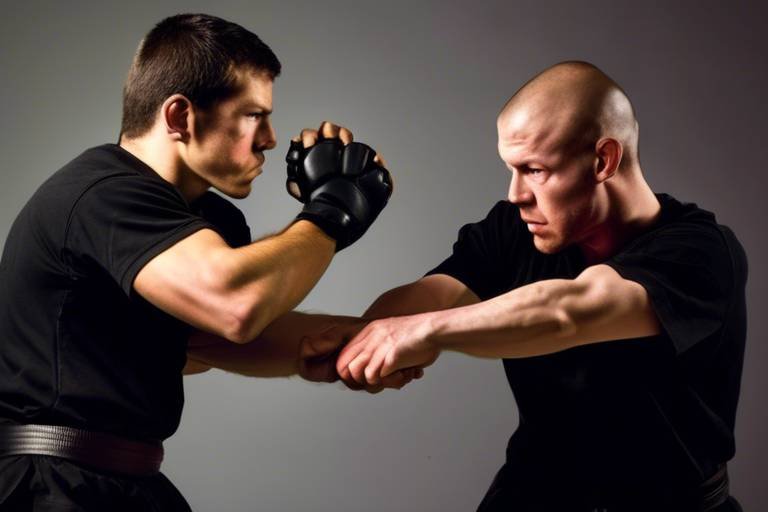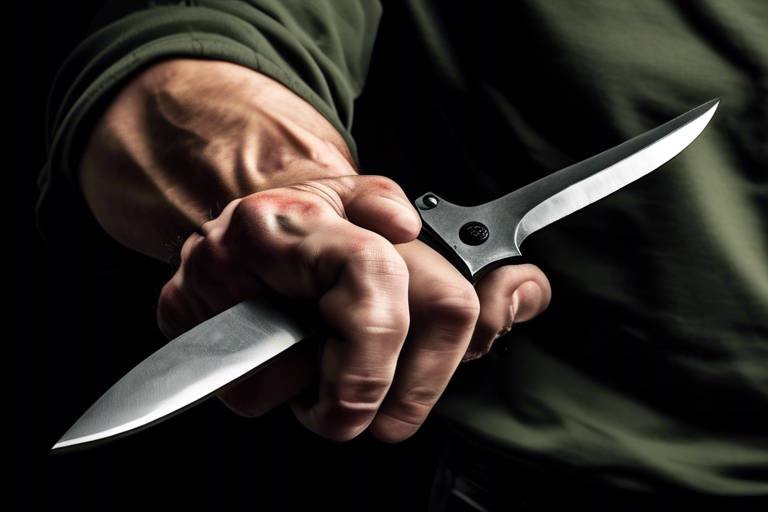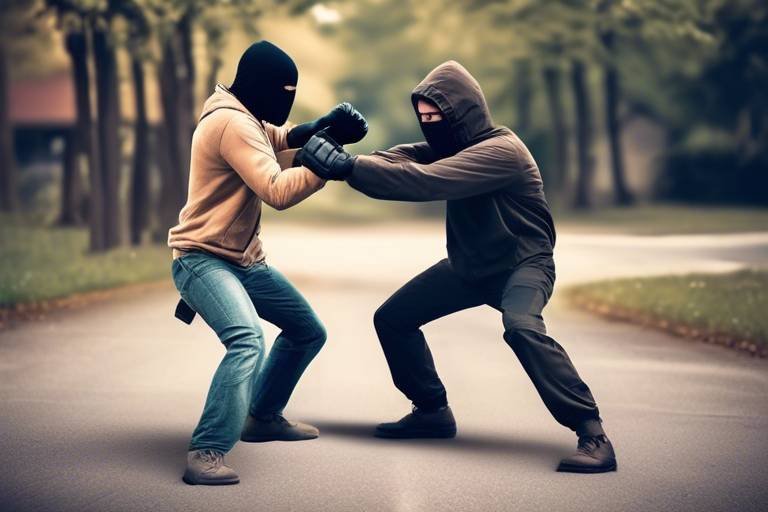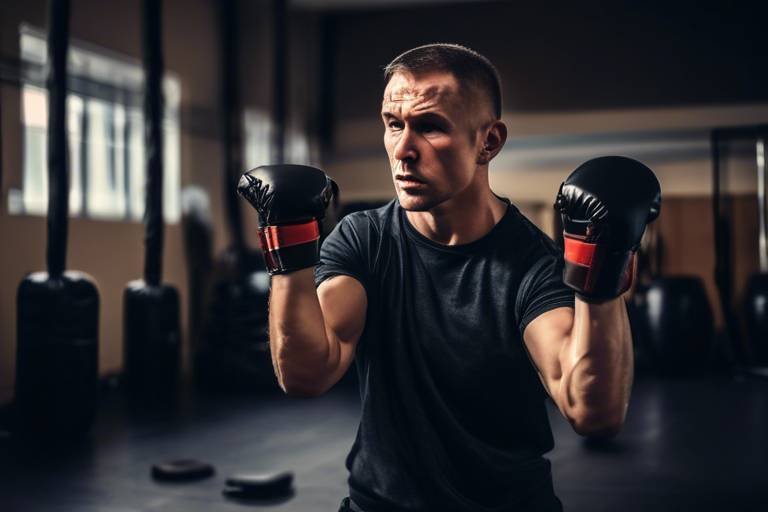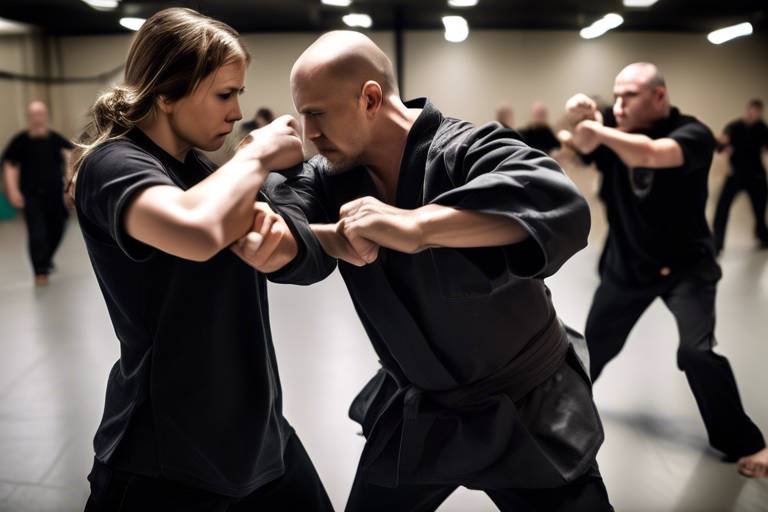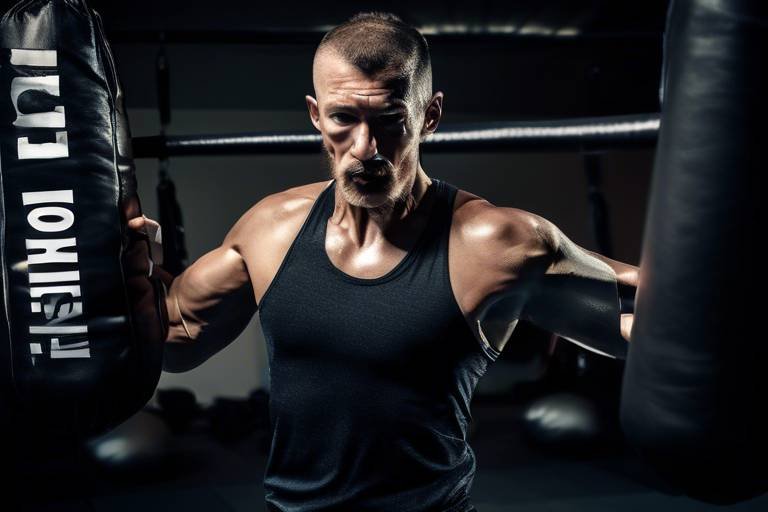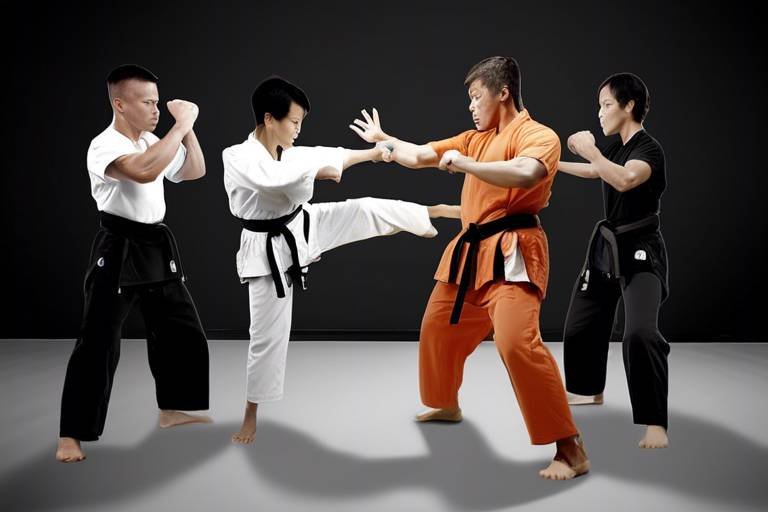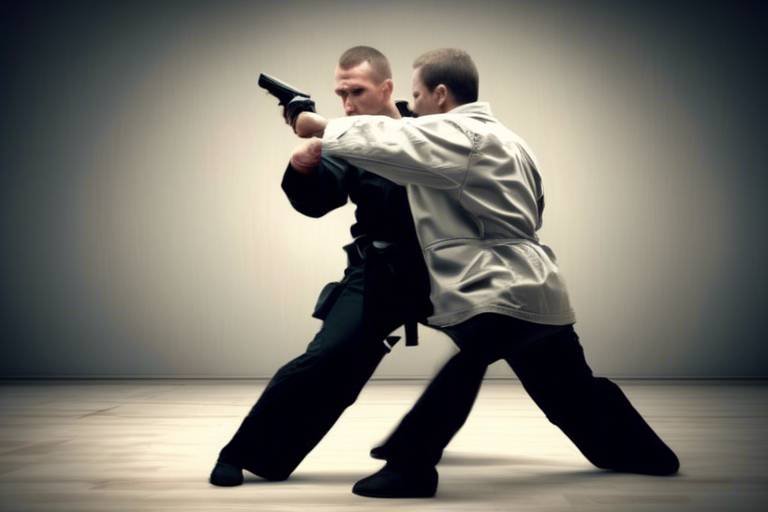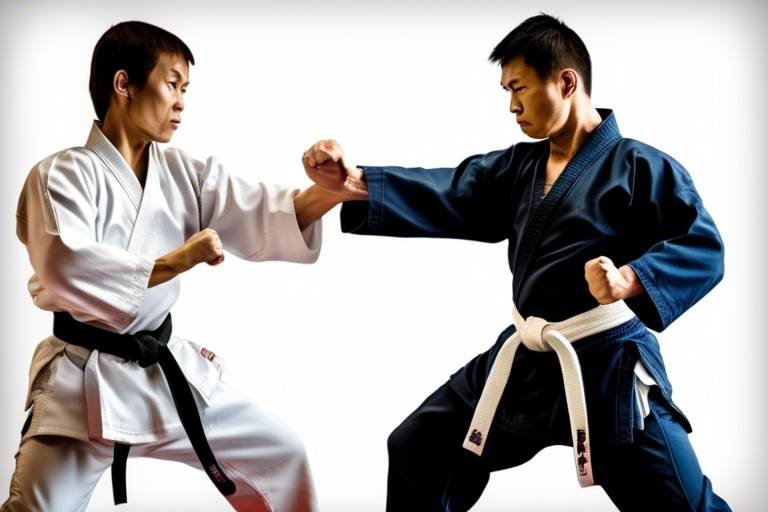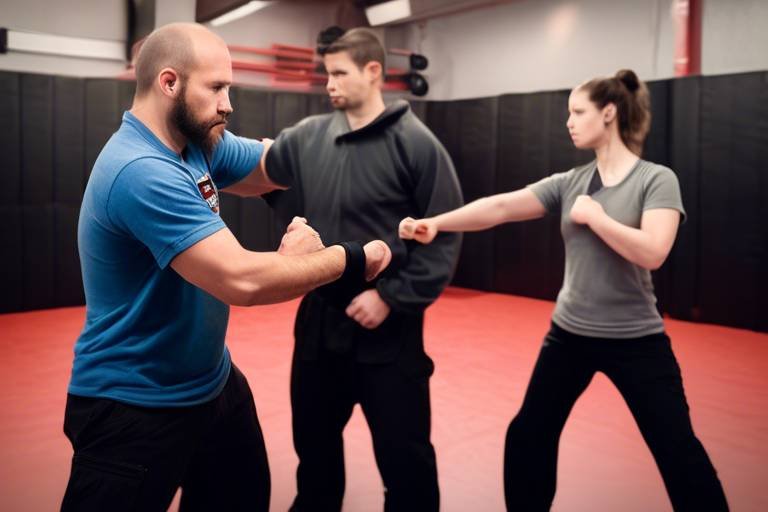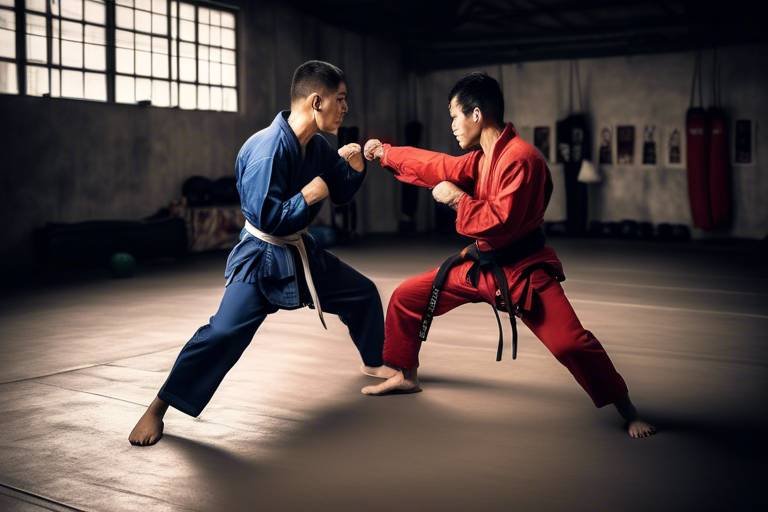A Comprehensive Guide to Self-Defense Techniques for the Disabled
This article provides essential self-defense techniques tailored for individuals with disabilities, ensuring safety, empowerment, and confidence in various situations. Learn practical strategies and tools for effective self-protection.
When it comes to self-defense, the challenges faced by disabled individuals are unique and often overlooked. Physical limitations can make traditional self-defense techniques feel inaccessible or impractical. However, it's crucial to understand that self-defense is not just about physical strength; it's about awareness, strategy, and adaptability. Tailored techniques that consider these limitations can empower individuals to protect themselves effectively. Imagine self-defense not as a one-size-fits-all solution but as a flexible toolkit that can be customized to fit your specific needs. This mindset shift is essential for anyone looking to enhance their personal safety.
Selecting the appropriate self-defense techniques is a critical step in ensuring personal safety. It involves a thoughtful assessment of your abilities and an honest evaluation of your strengths and limitations. Techniques that may work for one person might not be suitable for another, making it vital to choose methods that resonate with you. Think of it like picking the right pair of shoes; they should fit comfortably and support your journey. Consider factors such as mobility, balance, and any specific challenges posed by your disability. The right techniques will not only boost your confidence but also enhance your ability to respond effectively in a threatening situation.
Understanding physical limitations is vital for effective self-defense. Common disabilities can include mobility impairments, visual or hearing challenges, and cognitive disabilities. Each of these conditions requires unique adaptations to standard self-defense techniques. For instance, someone with limited mobility might focus on techniques that utilize leverage or target vulnerable areas rather than relying on speed or strength. By recognizing your limitations, you can adapt techniques to make them more accessible. This might involve practicing specific moves that can be performed from a seated position or using assistive devices as tools for defense.
Using adaptive equipment can significantly enhance self-defense capabilities for disabled individuals. There are various tools available that can provide an added layer of safety. Here are some options:
- Self-Defense Keychains: Compact and easy to carry, these can be used to strike an attacker.
- Personal Alarms: Loud alarms can deter attackers and attract attention.
- Walking Canes: These can serve a dual purpose; as mobility aids and as self-defense tools.
- Stun Guns: For those who can carry them legally, stun guns can incapacitate an attacker temporarily.
Choosing the right equipment can empower you, providing confidence in your ability to defend yourself.
Finding the right training resources is essential for skill development. Various classes and programs are specifically designed for individuals with disabilities, promoting confidence and competence. These programs often focus on adaptive techniques that cater to different needs. Look for local self-defense classes or community programs that emphasize inclusivity. Online resources, including video tutorials and virtual workshops, can also be beneficial. Engaging with a supportive community can provide motivation and encouragement, making the learning process enjoyable and effective.
Mental readiness is just as important as physical techniques when it comes to self-defense. Building confidence and awareness can make a significant difference in how you respond to potential threats. Consider practicing visualization techniques where you imagine yourself successfully defending against an attacker. This mental rehearsal can prepare you for real-life situations, helping to reduce anxiety and increase your response time. Remember, self-defense is not just about physical confrontation; it's also about being aware of your surroundings and trusting your instincts.
Understanding the legal implications of self-defense is crucial for everyone, especially for disabled individuals. Laws surrounding self-defense can vary widely depending on your location, and it's essential to be informed about your rights. Knowing the legal boundaries can empower you to act decisively while ensuring you stay within the law. This knowledge can also alleviate fears of legal repercussions after a confrontation, allowing you to focus on your safety.
Being aware of your legal rights in self-defense situations is empowering. It’s important to understand that you have the right to protect yourself from harm, but the use of force must be reasonable and proportional. Familiarize yourself with local laws regarding self-defense, as they can differ significantly. This knowledge not only prepares you for potential confrontations but also reassures you that you are acting within your legal rights when protecting yourself.
Reporting incidents is a critical step in the self-defense process. Disabled individuals should feel empowered to report self-defense situations effectively. This could involve contacting the police, documenting the incident, or seeking support from advocacy groups. Ensuring your voice is heard is vital for both personal safety and broader community awareness. Remember, every report contributes to a larger narrative that can help improve safety for everyone.
Q: What if I can't physically defend myself?
A: Self-defense is not solely about physical strength. Focus on awareness, avoidance, and using tools or techniques that suit your abilities.
Q: Are there self-defense classes specifically for disabled individuals?
A: Yes! Many organizations offer classes tailored for individuals with disabilities, focusing on adaptive techniques.
Q: What legal protections do I have in self-defense situations?
A: Your rights can vary by location, but generally, you have the right to protect yourself from harm. It’s best to familiarize yourself with local laws.

Understanding Self-Defense for Disabled Individuals
Self-defense is an essential skill that everyone should consider mastering, but for individuals with disabilities, the approach to self-defense can be quite different. The unique challenges faced by disabled individuals in self-defense scenarios can be overwhelming. Whether it’s mobility issues, sensory impairments, or cognitive challenges, these factors can significantly impact one's ability to respond to threats. Therefore, it’s crucial to develop self-defense techniques that are not only effective but also tailored to accommodate these physical limitations.
Imagine walking down the street and suddenly feeling unsafe. For many, instinct kicks in, and they can quickly assess their surroundings and react. However, for someone with a disability, that reaction may not come as easily. This is why understanding the specific challenges is the first step towards empowerment. By recognizing these hurdles, we can better adapt self-defense strategies to ensure that everyone, regardless of their physical capabilities, can feel safe and confident.
One of the primary challenges is the physical limitation that might restrict movement or speed. For instance, someone who uses a wheelchair may not be able to run away from a threat, but they can employ techniques that leverage their wheelchair's mobility. Similarly, someone with limited strength can learn to use their environment to their advantage. For example, utilizing objects around them as barriers or shields can provide crucial seconds needed to escape a threatening situation.
Moreover, self-defense is not solely about physical confrontation; it also encompasses awareness and prevention strategies. Individuals with disabilities can benefit from learning to recognize potentially dangerous situations before they escalate. This heightened awareness can be achieved through various means, such as:
- Practicing situational awareness techniques
- Engaging in role-playing scenarios
- Understanding personal triggers and responses
Furthermore, self-defense training should also focus on **verbal de-escalation techniques**. Often, a calm and assertive verbal response can diffuse a potentially violent situation without physical confrontation. Training programs that incorporate these strategies can empower individuals, allowing them to handle situations confidently while minimizing the risk of harm.
In conclusion, understanding self-defense for disabled individuals is about acknowledging the unique challenges they face and adapting techniques accordingly. Empowerment comes from knowledge and practice. By tailoring self-defense strategies to meet individual needs, we can ensure that everyone has the opportunity to protect themselves effectively. Remember, self-defense is not just about fighting back; it’s about being prepared, aware, and confident in your ability to handle any situation that may arise.

Choosing the Right Self-Defense Techniques
Choosing the right self-defense techniques is not just about picking a random method; it’s about understanding your own strengths, limitations, and the specific circumstances you might face. It’s like choosing the right tool for a job—if you don’t have the right tool, the job becomes much harder. For individuals with disabilities, this choice can be even more critical. The key is to assess your personal abilities and select methods that align with those strengths while also considering your unique challenges.
First and foremost, take a moment to reflect on your physical capabilities. Are you more agile than strong? Do you have limited mobility in certain areas? This self-assessment is crucial. For instance, if you have a mobility impairment, techniques that rely heavily on physical strength might not be your best bet. Instead, consider techniques that focus on leverage or using your environment to your advantage. Think of it as a dance—knowing your rhythm allows you to move gracefully even in challenging situations.
Additionally, understanding the context in which you might need to defend yourself is essential. Self-defense isn’t just about physical confrontation; it’s also about awareness and prevention. For example, if you often find yourself in crowded places, techniques that emphasize evasion and quick escapes may be more effective than those that require prolonged physical engagement. You want to be like a shadow—quick and elusive, rather than a heavy object that can be easily caught.
It’s also worth considering the psychological aspect of self-defense. Confidence plays a significant role in how you respond to threats. If you feel unsure about your abilities, it can hinder your effectiveness. Therefore, choose techniques that not only suit your physical capability but also boost your confidence. Some individuals might find that practicing assertiveness and verbal self-defense can be just as empowering as physical techniques. It’s about finding what resonates with you and making it a part of your self-defense toolkit.
Moreover, training is a vital component of choosing the right self-defense techniques. Look for classes or resources specifically designed for individuals with disabilities. These programs often tailor their approaches to accommodate various needs, ensuring that you not only learn effective techniques but also feel supported throughout the process. Remember, every expert was once a beginner, and the journey to mastery begins with the right guidance.
Lastly, consider adaptive techniques that can be integrated into your self-defense repertoire. For instance, if you use a wheelchair, there are specific techniques designed to help you leverage your chair for protection. Similarly, if you have a visual impairment, learning to rely on your other senses can enhance your situational awareness. It’s about adapting traditional methods to fit your unique situation, much like customizing a recipe to suit your taste.
In summary, choosing the right self-defense techniques involves a blend of self-awareness, understanding your environment, building confidence, and seeking appropriate training. By focusing on your strengths and adapting techniques to fit your needs, you can empower yourself and enhance your safety in any situation.
- What should I consider when choosing self-defense techniques?
Consider your physical abilities, the environments you frequent, and your comfort level with different techniques.
- Are there self-defense classes specifically for disabled individuals?
Yes, many organizations offer classes tailored to the needs of individuals with disabilities, focusing on accessible techniques.
- Can self-defense techniques be adapted for those with mobility impairments?
Absolutely! Many techniques can be modified to utilize leverage, positioning, and environmental awareness to enhance safety.

Physical Limitations and Adaptations
When it comes to self-defense, understanding physical limitations is crucial for anyone, but especially for individuals with disabilities. Every person has unique abilities and challenges, and recognizing these can significantly influence the effectiveness of self-defense techniques. For instance, someone with limited mobility may find it difficult to execute certain moves that require agility or speed. In contrast, an individual with visual impairments might rely more on their other senses, such as hearing and touch, to assess a situation. Therefore, it’s essential to adapt traditional self-defense methods to fit personal capabilities.
Adapting techniques means being creative and resourceful. For example, if a person has limited use of their arms, they might focus on using their body weight to create distance between themselves and an attacker. Techniques such as hip throws or using a wheelchair for mobility can be incredibly effective. Additionally, individuals can learn to use their environment to their advantage. A simple object like a cane or a backpack can serve as a barrier or a tool for self-protection, transforming everyday items into powerful aids.
Moreover, it's vital to consider the mental aspect of these adaptations. Acknowledging one’s limitations does not equate to a lack of strength. On the contrary, it can empower individuals to approach self-defense with a mindset of adaptability and resilience. For instance, a person who uses a wheelchair can practice techniques that involve maneuvering their chair in a way that creates a protective barrier or allows for quick escapes. This mindset shift can transform feelings of vulnerability into a sense of control and empowerment.
To illustrate the importance of adapting techniques, consider the following table that outlines common disabilities alongside suggested adaptations for self-defense:
| Disability | Suggested Adaptations |
|---|---|
| Limited Mobility | Focus on body weight techniques, use of wheelchair, and environmental awareness. |
| Visual Impairment | Enhance auditory and tactile awareness; practice techniques that rely on sound and touch. |
| Hearing Impairment | Utilize visual cues and develop strong situational awareness; consider using a personal alarm system. |
| Neurodiversity | Implement routines and familiar techniques to reduce anxiety; practice in non-threatening environments. |
In summary, adapting self-defense techniques to accommodate physical limitations doesn’t just make the practice more accessible; it enhances overall confidence and effectiveness. It’s about finding what works best for you, embracing your unique strengths, and transforming potential challenges into effective strategies. Remember, self-defense is not solely about physical prowess; it’s about being aware, prepared, and confident in your ability to protect yourself.
As we continue to explore self-defense, keep in mind that the journey is as important as the destination. Embrace your individuality, and let it guide you in developing a self-defense strategy that resonates with your personal experience.

Adaptive Equipment for Self-Defense
When it comes to self-defense, having the right tools can make all the difference, especially for individuals with disabilities. Adaptive equipment is designed to enhance self-defense capabilities, ensuring that everyone, regardless of their physical limitations, can feel empowered and safe. Imagine being armed not just with skills, but also with tools that cater specifically to your needs. This creates a powerful combination of confidence and preparedness.
There are several types of adaptive equipment that can significantly aid in self-defense situations. These tools range from personal alarms to specialized self-defense weapons that are easier to handle for individuals with limited mobility. For instance, personal alarms are compact devices that emit loud sounds when activated, drawing attention and potentially scaring off an attacker. They are easy to carry and can be activated with a simple press of a button, making them accessible for anyone.
Another effective tool is the self-defense keychain. These are small, often decorative items that can be used to strike an attacker. Many designs are lightweight and can be easily gripped, allowing individuals with limited strength or dexterity to wield them effectively. Additionally, pepper spray is a popular choice, but it’s crucial to ensure that the canister is easy to hold and spray. Some brands offer ergonomic designs specifically for those with grip issues.
For individuals who may use wheelchairs or other mobility aids, defensive tools can be integrated into their equipment. For example, a wheelchair user might consider a defensive cane—a sturdy cane that can double as a self-defense tool. These canes are often designed with a pointed end or a hidden compartment for carrying small defensive items, allowing for both mobility and protection.
Moreover, it’s essential to consider the psychological aspect of using adaptive equipment. Just knowing that you have tools at your disposal can significantly boost confidence. This mental readiness can be as important as the physical tools themselves. It’s about creating a mindset where you feel prepared to handle unexpected situations, which can be achieved through practice and familiarization with your chosen equipment.
In conclusion, the right adaptive equipment can enhance self-defense for individuals with disabilities, providing them with the means to protect themselves effectively. It's not just about having tools; it's about empowerment and the assurance that one can take action in a challenging situation. As you explore various options, remember to choose equipment that feels comfortable and aligns with your unique needs and abilities.
- What types of adaptive equipment are best for self-defense? The best types include personal alarms, self-defense keychains, pepper spray, and defensive canes, all designed to be user-friendly for individuals with disabilities.
- Where can I find training for using adaptive self-defense equipment? Many local self-defense classes and community centers offer training specifically tailored for individuals with disabilities. Online resources are also available.
- Is it legal to carry self-defense equipment? Laws vary by location, so it's important to research local regulations regarding the possession and use of self-defense tools.
- How can I build confidence in using self-defense techniques? Regular practice, attending classes, and familiarizing yourself with your equipment can significantly boost your confidence in self-defense situations.

Training Resources and Classes
Finding the right training resources and classes is essential for individuals with disabilities who want to learn self-defense techniques tailored to their unique needs. These classes not only focus on physical skills but also emphasize mental preparedness, which is equally important in self-defense scenarios. Many organizations and instructors specialize in adaptive self-defense training, ensuring that each participant feels empowered and confident in their abilities.
When searching for training programs, it’s crucial to consider factors like the instructor's experience with disabilities, the class size, and the training environment. A supportive atmosphere can significantly enhance learning and confidence. Many programs offer a range of options, from one-on-one training to group classes, allowing individuals to choose what suits them best.
Here’s a brief overview of some popular training resources and classes available for disabled individuals:
| Organization | Location | Focus Area | Contact |
|---|---|---|---|
| Adaptive Martial Arts | Various Locations | Self-Defense Techniques | info@adaptivemartialarts.com |
| Disability Self-Defense Network | Online | Virtual Classes | contact@dsdn.org |
| Empowerment Through Movement | Local Community Centers | Adaptive Fitness & Self-Defense | info@empowermentmovement.org |
Additionally, many community centers and local gyms are beginning to offer adaptive self-defense classes, recognizing the importance of inclusivity in fitness and self-protection. If you don’t find a suitable class in your area, consider reaching out to local martial arts studios and inquiring if they can accommodate your needs.
Online platforms have also become a valuable resource, providing access to self-defense training videos and virtual classes. This flexibility allows individuals to train at their own pace and comfort level, which can be particularly beneficial for those with mobility challenges. Remember, the key is to find a program that resonates with you and meets your specific requirements.
Ultimately, self-defense is not just about physical techniques; it's about building confidence, awareness, and the ability to respond effectively in various situations. By engaging in the right training resources and classes, individuals with disabilities can cultivate these essential skills, empowering them to navigate the world with greater assurance and safety.

Psychological Preparedness
When it comes to self-defense, many people think of physical techniques and strategies, but is just as crucial, especially for individuals with disabilities. Imagine walking into a room full of strangers; your heart races, and your mind starts to whirl with thoughts of potential danger. This feeling is common, but being mentally prepared can help you stay calm and focused during a confrontation. It's about creating a mental fortress that shields you from fear and anxiety, allowing you to react effectively when necessary.
One of the first steps in developing psychological preparedness is to build confidence. This can be achieved through practice and familiarization with self-defense techniques. The more you train, the more competent you'll feel. Think of it like learning to ride a bike; at first, it feels daunting, but with practice, you become more confident in your abilities. Engage in role-playing scenarios where you can visualize yourself responding to various situations. This mental rehearsal can significantly enhance your reaction time and decision-making skills when faced with real-life threats.
Additionally, cultivating a strong sense of awareness is vital. Being aware of your surroundings helps you anticipate potential dangers before they escalate. Consider this: when you're walking through a park, instead of being glued to your phone, take a moment to observe the people around you. Are there any unusual behaviors? Is someone following you? Developing this habit can help you notice red flags early, allowing you to react appropriately. You can also practice mindfulness techniques, which can enhance your focus and help you remain calm under pressure.
Another essential aspect of psychological preparedness is understanding your emotional triggers. Everyone has certain situations that make them feel anxious or threatened. By identifying these triggers, you can work on strategies to manage your reactions. For instance, if you know that crowded places make you anxious, you might want to practice deep-breathing exercises or grounding techniques that can help you stay centered. Remember, self-defense isn't just about physical strength; it's about maintaining control over your mind and emotions.
To further enhance your psychological preparedness, consider joining support groups or self-defense classes specifically designed for individuals with disabilities. These environments can foster a sense of community and provide valuable insights from others who share similar experiences. Sharing stories and strategies can empower you and reinforce the idea that you are not alone in your journey toward self-protection.
In conclusion, psychological preparedness is a multifaceted approach that combines confidence-building, awareness, emotional management, and community support. By focusing on these elements, individuals with disabilities can enhance their self-defense capabilities significantly. Remember, the mind is a powerful tool in self-defense; when you prepare mentally, you equip yourself to handle any situation with poise and resilience.
- What is psychological preparedness in self-defense?
It refers to the mental readiness and confidence to respond effectively in self-defense situations. - How can I build confidence for self-defense?
Practice self-defense techniques consistently and engage in mental rehearsal of various scenarios. - What role does awareness play in self-defense?
Being aware of your surroundings helps you identify potential threats early, allowing for proactive responses. - Can mindfulness techniques help in self-defense?
Yes, mindfulness can enhance focus and calmness, which are crucial during high-stress situations. - Are there classes for self-defense tailored for disabled individuals?
Absolutely! Many organizations offer specialized self-defense classes designed to accommodate various disabilities.

Legal Considerations in Self-Defense
Understanding the legal implications of self-defense is crucial for anyone, but it holds particular significance for disabled individuals. The law can be a complex maze, and when it comes to self-defense, the rules can vary widely depending on your location. It’s essential to grasp not only the general principles of self-defense but also how they apply to your unique circumstances. For instance, what constitutes a reasonable response to a threat can differ based on your physical capabilities and the nature of the threat itself. This understanding empowers you to act confidently and within the law when faced with a dangerous situation.
In many jurisdictions, the law recognizes the right to defend oneself against imminent harm. However, the key lies in the concept of proportionality. This means that your response must be proportionate to the threat you face. For example, if someone is verbally threatening you but is not physically aggressive, using physical force in return could be seen as excessive. On the other hand, if you are physically attacked, you are generally justified in defending yourself. However, it is crucial to remember that the law often requires you to retreat if it is safe to do so before using physical force, especially in public spaces.
For disabled individuals, the idea of proportionality can be particularly nuanced. If you have a physical limitation that affects your ability to escape or defend yourself, the law may take that into account. This is why understanding your rights is so vital. You need to be aware of how your disability could influence the perception of your actions in a self-defense scenario. This understanding not only helps in making informed decisions during confrontations but also plays a crucial role should you need to explain your actions to law enforcement or, in some cases, a court.
Moreover, it’s important to document any incidents of self-defense thoroughly. Keeping records of what happened, including details about the threat and your response, can be invaluable. This documentation can help you articulate your side of the story if legal action arises. Always remember, the aftermath of a self-defense situation can be just as critical as the event itself.
Here’s a quick overview of some legal considerations to keep in mind:
- Know Your Rights: Familiarize yourself with local laws regarding self-defense.
- Proportionality: Ensure your response is appropriate to the threat level.
- Documentation: Keep detailed records of any incidents.
- Seek Legal Advice: Consult with a legal professional if you have specific questions or concerns.
By arming yourself with knowledge about the legal landscape surrounding self-defense, you can navigate potentially dangerous situations with a sense of empowerment. The goal is not just to protect yourself physically but also to safeguard your rights and ensure that you can articulate your actions clearly and confidently if needed.
Q: What should I do immediately after a self-defense incident?
A: First, ensure your safety and that of others. Then, document the incident as thoroughly as possible, including taking photos if necessary, and report it to the authorities.
Q: Can I use self-defense techniques if I feel threatened but not physically attacked?
A: It's essential to assess the situation. If you believe you are in imminent danger, you may have the right to defend yourself, but ensure your response is proportional to the threat.
Q: How can I find legal assistance if I need it?
A: Look for local legal aid organizations or consult with a lawyer who specializes in self-defense cases. Many communities offer resources for individuals with disabilities.

Know Your Rights
In the realm of self-defense, understanding your rights is not just a legal formality; it’s a vital aspect of empowerment, especially for individuals with disabilities. Every person, regardless of their physical abilities, has the inherent right to protect themselves from harm. This right is enshrined in various laws, but the application can often feel daunting. So, what does this mean for you? It means that you have the right to defend yourself if you are faced with an imminent threat, and knowing how to navigate these waters can provide you with a sense of security and confidence.
When discussing self-defense, it's crucial to recognize that laws can vary significantly depending on where you live. In most jurisdictions, the use of reasonable force in self-defense is permissible, but what constitutes 'reasonable' can be subjective. For instance, if someone were to attack you, you are allowed to use force to protect yourself, but that force must be proportional to the threat. This means that if someone is pushing you, responding with a lethal weapon could be seen as excessive force. Understanding these nuances is essential for anyone, but particularly for disabled individuals who may face unique challenges in a confrontation.
Moreover, it’s important to familiarize yourself with local laws regarding self-defense. Some states have "stand your ground" laws, while others may require you to retreat if safe to do so. This can be especially pertinent for disabled individuals who may not have the same mobility options as others. Knowing whether you are legally required to attempt to escape a situation can impact your decision-making in a critical moment. To ensure you are well-informed, consider consulting local legal resources or attending workshops that focus on self-defense laws.
Here are a few key points to remember regarding your rights in self-defense situations:
- You have the right to defend yourself: If you are threatened, you can use reasonable force to protect yourself.
- Understand the concept of proportionality: Your response must match the level of threat you are facing.
- Familiarize yourself with local laws: Laws differ by location, so knowing your local regulations is crucial.
- Document incidents: If you have to defend yourself, make sure to gather evidence and report the incident to authorities.
In addition to knowing your rights, it’s also beneficial to understand how to advocate for yourself. This means being able to express your needs and concerns clearly, whether that’s in a self-defense class or when interacting with law enforcement. If you ever find yourself in a situation where you need to defend yourself, being articulate about your experience can help ensure that your perspective is understood. Remember, the goal is to protect yourself while also being aware of the legal implications of your actions.
Finally, always be aware that your rights extend beyond the moment of confrontation. If you find yourself involved in a legal situation following a self-defense incident, seek legal counsel. An attorney who specializes in self-defense cases can provide you with guidance tailored to your specific circumstances, ensuring that you navigate the legal landscape effectively.
Q: What should I do immediately after a self-defense incident?
A: Ensure your safety first, then contact law enforcement to report the incident. Document everything that happened while it’s still fresh in your mind.
Q: Can I face legal repercussions for defending myself?
A: While you have the right to defend yourself, the legality of your actions can depend on the circumstances and local laws. It’s crucial to understand the laws in your area.
Q: How can I prepare myself legally for a self-defense situation?
A: Educate yourself on local self-defense laws, consider attending self-defense classes that cover legal aspects, and consult with a legal professional if you have specific concerns.

Reporting Incidents
When it comes to self-defense, knowing how to report incidents effectively is crucial, especially for individuals with disabilities. It's not just about defending oneself; it's also about ensuring that your voice is heard and that any threats are addressed appropriately. Imagine you’ve just faced a threatening situation; your heart is racing, and your mind is swirling with emotions. The last thing you want is to feel powerless again. This is why understanding the reporting process can empower you and provide a sense of control.
First and foremost, it's essential to document everything. As soon as it's safe to do so, write down every detail of the incident. This includes the time, date, location, and a description of the person or people involved. Consider using your phone to record an audio note or take pictures of the scene if applicable. This evidence can be invaluable when you report the incident. Think of it as creating a clear picture for authorities; the more details you provide, the better they can assist you.
Next, reach out to law enforcement. You can do this in person or by calling the non-emergency police line if the situation does not require immediate action. When speaking with the police, remain calm and provide them with the documented details you prepared. It's important to communicate clearly and assertively. Remember, you have every right to report what happened, and your experience is valid. If you feel uncomfortable or unable to communicate effectively due to your disability, consider bringing a friend or advocate who can help convey your message.
In addition to law enforcement, there are various organizations and support groups that specialize in assisting disabled individuals. These organizations can offer guidance on how to report incidents and may even provide legal assistance if needed. Connecting with community resources not only helps you navigate the reporting process but also fosters a sense of belonging and support. You might find it helpful to reach out to groups that understand your unique challenges and can offer tailored advice.
Lastly, don't underestimate the importance of emotional support after an incident. Reporting can be a daunting task, and it’s perfectly normal to feel shaken afterward. Engaging with a counselor or support group can help you process your feelings and reinforce your mental preparedness for any future incidents. Remember, self-defense is not just about physical techniques; it also encompasses emotional resilience.
In summary, reporting incidents effectively involves:
- Documenting Details: Write down everything you can remember about the incident.
- Contacting Law Enforcement: Report the incident calmly and clearly, providing all necessary information.
- Utilizing Community Resources: Seek help from organizations that understand the specific needs of disabled individuals.
- Seeking Emotional Support: Engage with professionals or support groups to process your experience.
By following these steps, you not only protect yourself but also contribute to a safer community. Remember, your experience matters, and taking action can help prevent similar situations from occurring in the future.
- What should I do immediately after a self-defense incident?
Document the incident, seek safety, and contact law enforcement as soon as possible.
- Can I report an incident if I feel it was not serious?
Yes, it’s always best to report any incident, no matter how minor it may seem. Your safety is paramount.
- What if I don’t feel comfortable speaking to the police?
Consider bringing a trusted friend or advocate with you, or contact organizations that can assist you.
- Are there support groups for disabled individuals after incidents?
Yes, many organizations provide support and resources to help individuals process their experiences.
Frequently Asked Questions
-
What self-defense techniques are most effective for individuals with disabilities?
Self-defense techniques that focus on leveraging one's strengths and minimizing physical limitations are often the most effective. Techniques such as using pressure points, striking vulnerable areas, and employing adaptive tools can enhance self-defense capabilities. It's crucial to choose methods that align with personal abilities and comfort levels.
-
How can I assess which self-defense techniques are right for me?
Assessing the right self-defense techniques involves understanding your own physical abilities, limitations, and comfort zones. Consider factors like mobility, strength, and any specific disabilities you may have. Consulting with a self-defense instructor who specializes in adaptive techniques can also provide personalized guidance.
-
Are there specific training resources available for disabled individuals?
Yes! Many organizations and martial arts schools offer classes tailored for individuals with disabilities. These programs focus on adaptive techniques and provide a supportive environment for learning. Look for local self-defense classes or online resources that emphasize inclusivity and accessibility.
-
What kind of adaptive equipment can help in self-defense?
Adaptive equipment can range from personal alarms and pepper sprays to specialized mobility aids designed for self-defense. Items like tactical canes or self-defense keychains can enhance your ability to protect yourself while being easy to carry and use. Always choose equipment that you feel comfortable with and can easily access.
-
How important is mental preparedness in self-defense?
Mental preparedness is just as crucial as physical techniques. Building confidence and situational awareness can significantly improve your ability to respond effectively during a confrontation. Practicing visualization techniques and role-playing scenarios can help you feel more prepared and empowered.
-
What legal rights do disabled individuals have regarding self-defense?
Disabled individuals have the same legal rights as anyone else when it comes to self-defense. It's important to be aware of local laws and regulations governing self-defense actions. Understanding your rights can empower you to act confidently and within legal boundaries during a confrontation.
-
How should I report a self-defense incident?
Reporting a self-defense incident should be done promptly and clearly. Gather all relevant information, including details of the incident, witnesses, and any injuries sustained. Contact local law enforcement or appropriate authorities to file a report, ensuring your voice is heard and necessary actions are taken.



